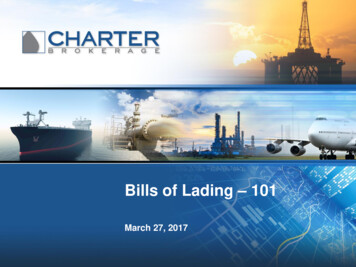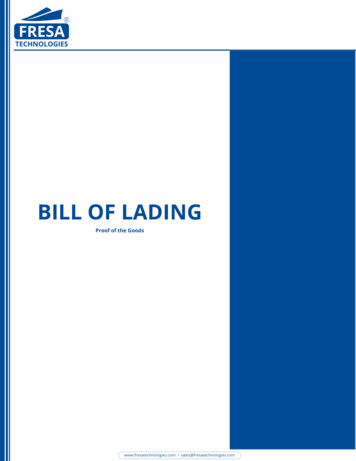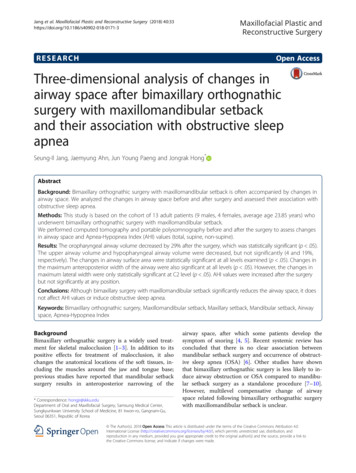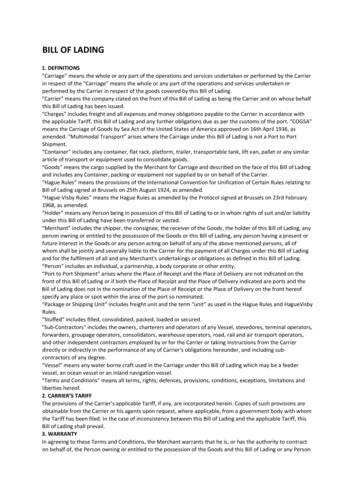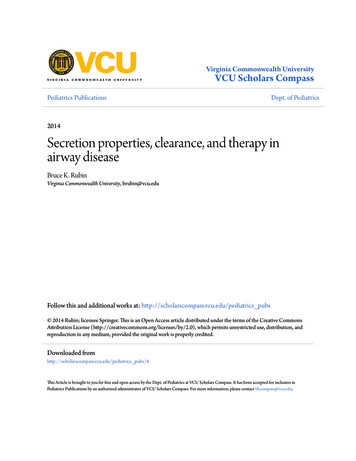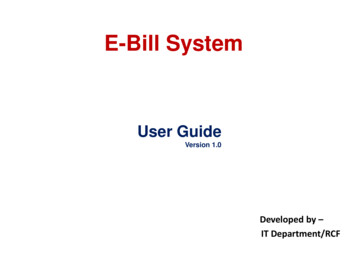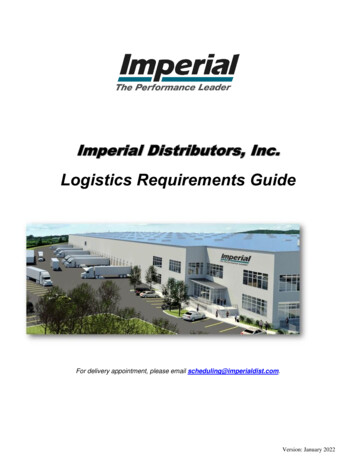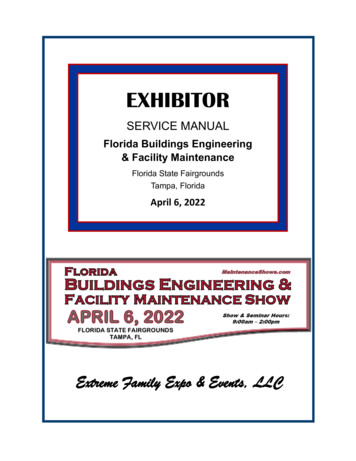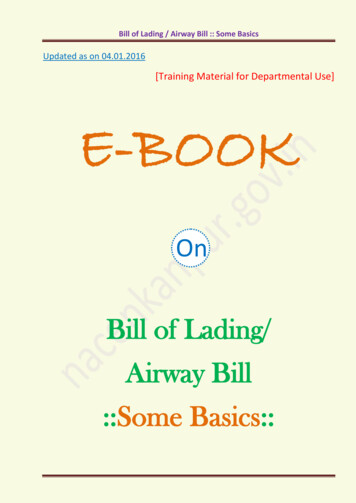
Transcription
Bill of Lading / Airway Bill :: Some BasicsUpdated as on 04.01.2016[Training Material for Departmental Use]E-BOOKOnBill of Lading/Airway Bill::Some Basics::
Bill of Lading / Airway Bill :: Some BasicsNote:1.In this E-book, attempts have been made to explain „how to understand Bill ofLading / Airway Bill’. It is expected that it will help departmental officers in theirday to day work.2.Though all efforts have been made to make this document error free, but it ispossible that some errors might have crept into the document. If you notice anyerrors, the same may be brought to the notice to the NACEN, RTI, Kanpur on theEmail addresses: rtinacenkanpur@yahoo.co.in. This may not be a perfect E-book. Ifyou have any suggestion to improve this book, you are requested to forward thesame to us.3.If any officer is interested in preparing E-book on any topic relating to Customs,Central Excise or Service Tax, he may forward the E-book prepared by him to theEmail addresses mentioned above. After necessary vetting, we will include the samein our E-book library for benefit of all Departmental officers.4.The matter in this e-Book is based on variety of sources including material freelyavailable on Internet/Websites. The purpose of this e-Book is primarily educationand training. It is not our intention to infringe any copyrights. However, if anybodyhas any issue with regard to any of the material used in this e-Book, the same maykindly be brought to my notice on the email address mentioned above.5.This e-book has been prepared with active assistance and contribution of Shri V.Jagannadh, Superintendent of Customs, Air Cargo, Delhi. We, at NACEN,appreciate his participation and willingness to prepare e-books so as to help fellowdepartmental officers in capacity building and upgrading their knowledge.6.If you feel that this e-book has really helped you in improving your knowledge orunderstanding of the subject matter, we request you to take few minutes out of yourprecious time and provide us your valuable feedback. Your feedback is importantand will help us in improving our e-books.Sd/-(C. P. Goyal)Additional Director General,
Bill of Lading / Airway Bill :: Some BasicsNACEN, RTI, Kanpur
Bill of Lading / Airway Bill :: Some BasicsINDEX1.Introduction . 12.Scope of this E-book . 23.What is Bill of Lading? . 34.What is Airway Bill? . 35.What Information is available on Bill of Lading/Airway Bill . 56.Risk indicators. 57.A.Attempt to conceal the identity of Importer . 5B.Profile of Persons/CompaniesInvolved . 6C.Check the routing of the Consignment . 6D.Unusual Weight/Volume ratio of the goods. 7E.Method of Shipping . 8F.Description of the goods on the Bill of Lading/Airway Bill . 8G.Origin of goods . 9H.Unusual Term of payment . 10I.Sign of undue haste . 10J.Packaging of Shipment. 11K.Unavailability of certain documents normally available with consignment. . 11L.Falsification of documents . 11Formats of Bill of Lading/Airway Bill . 127. 1 Format of Bill of Lading . 12Explanation of the information contained in the Bill of Lading . 13
Bill of Lading / Airway Bill :: Some Basics1.Introduction1.1. In today‟s environment, where the volume of the goods being imported or exportedis continuously increasing, the number of Customs officers to deal with such goodshas remained same or decreased. Now, a Customs officer,no longer, has liberty tohold the goods for long time or to subject every consignment of imported /exportedgoods for detailed physical examination.1.2. In such a scenario, it becomes all the more important for the Customs officers tohave adequate expertise and knowledge to identify the high risk consignments on thebasis of documents or on the basis of declaration made by an importer/exporter.1.3. A Custom officer should always be aware of the fact that any smuggler/offender,howsoever smart he may be, would leave umpteen number of risk signs/signals (orred flags) while smuggling contraband/restricted goods. It is for the customs officersto understand these risk signs /signals and thwart any such attempts of smuggling ofcontraband into or out of the country. While doing their work, they should be alertand be attentive to details or risk signals.1.4. Any smuggling syndicate or smuggler has few concerns. His major concern is nondisclosure of identity in case of consignment attempted to be smuggled being caughtby the Customs Authorities. This concern leads to creating a web of layers in anyimport/export transaction, non–disclosure of details of recipient of goods till lastmoment, avoiding financial trail, payment of goods and freight charges in cash,assume identity of reputed firms for importation/exportation, use of non-existentaddresses or use of dummy person‟s name and address for transaction, etc.1.5. Another major concern is relating to the method of concealment used whether it isenough to outsmart the controls adopted by the Customs authority. The objective ofconcealment is to ensure that under normal circumstances, the Customs authoritiesshould not be able to detect the concealment of goods. This concern forces them tostudy in great details about the volume of import/exports, availability of equipmentand manpower available at different port/ICDs/CFSs, and making selection of portfor importation/exportation and choosing type and extent of packaging to beadopted.1.6. Other concerns are the extent of examination adopted by the Customs Authority,effectiveness of controls adopted by the Customs authority at the port of import orexport, and integrity and knowledge of the officers posted at the port. At times, wehear about Port-hopping where smuggling syndicate suddenly shift theirimports/exports from one Port to another. Sometimes, it is noticed thatNACEN, RTI, KanpurPage 1
Bill of Lading / Airway Bill :: Some Basicsimport/export goods being cleared from smaller Ports/ICDs/CFSs located far awayfrom the place where importer is located without any economic justification for thegreater inconvenience, higher transportation cost etc. Any such abnormal routeadopted by smuggling syndicate should ring alarm bells in the mind of the Customsofficer.1.7. As a Customs officer, one should learn talking to the documents. Any Customsofficer while scrutinizing documents should ask questions such as who?, why?,what?, where?, when?and how? If the document is not able to provide any coherentand consistent answers, it should raise doubts in the mind of the Customs Officer.Customs Officer should always ask one question while examining the documents orconsignment i.e. IS IT NORMAL?For example, Who is Shipper or consignor? Is he a regular shipper or first time shipper? Is the consignor a manufacturer or trader? Is the consignee a manufacturer or trader? Does Consignor have presence in virtual world? If not, why not? Who is the buyer or consignee or importer? Is it a regular importer of the goods in question from the port/ICDs/CFSs in thepast? Is the importer first time importer? Is the importer a manufacturer importer or a trading company? Does the importer have a history of compliance? Does the importer have presence in virtual world? If not, why not? Whether the address declared by Importer hassufficient details? Or it lack details?The above list of questions is not exhaustive, but indicative only.2.Scope of this E-bookNow, in this e-book, attempt has been made to decipher an important document,known as Bill of Lading (in case of sea transport) or Airway Bill in case of transport ofgoods by Air. The Bill of Lading/Airway Bill is basically a transportation document andnot a Custom document, but it is available to the Custom officer. Indeed, it is a crucialdocument from Custom‟s point of view as it provides lot of additional and importantinformation, whichotherwise, is not available on Bill of Entry and rather difficult tomanipulate.NACEN, RTI, KanpurPage 2
Bill of Lading / Airway Bill :: Some Basics3.What is Bill of Lading?3.1. The Bill of lading (also referred to as B/L) is a document issued by the Carrier or itsagent to the shipper of goods as a contract of carriage of goods. It is also a receiptfor cargo accepted for transportation. It must be presented for taking delivery of thegoods at the destination. The B/L serves as a proof of ownership or title of thecargo.3.2. It may be issued either in a negotiable or non-negotiable form. In case of negotiableform, it may be bought, sold or traded or used as security for borrowing money. Tobe negotiable the B/L must states “to order”. The ownership of the cargo belongs tothe person who is holding the negotiable bill of lading.3.3. The Non-Negotiable Bill of Lading declares that the cargo is consigned to a specificperson and is Non Negotiable. A B/L is required for settlement of all claims ofcompensation in case of any damage, delay or loss of cargo and for the resolution ofdisputes regarding ownership of the cargo. On the back of B/L, the rights,responsibilities and liabilities of the carrier and shipper are mentioned. These aregoverned by Hague Rules or by Hague-Visby Rules.3.4. Revised /amended Bill of Lading can be issued if required by the shipper orconsignee prior to vessel arrival at destination. The revision/amendment is alwayssubject to additional B/L amendment fee.3.5. Two terms i.e. Master Bill of lading and House Bill of lading are also commonly usedin transportation of goods by sea. The Master Bill of Lading is a document of titleissued by the carrier who will transport the cargo from the shipper to nameddestination. Acquiring possession of the master bill of lading is entitling possessionof the goods. The House Bill of Lading is issued by the freight forwarder,NVOCC who arrange goods transportation with the carrier. NVOCC stands forNon Vessel Owning Common Carrier. NVOCC operation comprises of sales,stuffing and transport of the containers to gateway ports.4.What is Airway Bill?4.1. An air waybill (AWB) or air consignment note is a receipt issued by an internationalairline for goods and an evidence of the contract of carriage, but it is not a documentof title to the goods ( unlike Bill of lading which is a document of title of the goods).Hence, the air waybill is non-negotiable.NACEN, RTI, KanpurPage 3
Bill of Lading / Airway Bill :: Some Basics4.2. The main functions of an air waybill serves are as under: Contract of Carriage: Behind every original of the Air Way bill, conditions ofcontract for carriage are mentioned. Evidence of Receipt of Goods: When the shipper delivers goods to beforwarded, he gets a receipt. The receipt is proof that the shipment has beenhanded over in good order and condition and also that the shipping instructions, ascontained in the Shipper's Letter of Instructions, are acceptable. After completion,an original copy of the air waybill is given to the shipper as evidence of theacceptance of goods and as proof of contract of carriage Freight Bill: The air waybill may be used as a bill or invoice together withsupporting documents since it may indicate charges to be paid by the consignee,charges due to the agent or the carrier. An original copy of the air waybill is usedfor the carrier's accounting Certificate of Insurance: The air waybill may also serve as an evidence if thecarrier is in a position to insure the shipment and is requested to do so by theshipper. Customs Declaration: Although customs authorities require various documentslike a commercial invoice, packing list, etc. the Airwaybill too is proof of thefreight amount billed for the goods carried and may be needed to be presented forcustoms clearance4.3. The format of the air waybill has been designed by IATA and these can be used forboth domestic as well as international transportation.4.4 Difference between Air Way bill and Bill of Lading at a glanceTableBill of Lading (B/L)Airway Bill (AWB)NegotiableNon NegotiableIt is issued after the complete consignmenthas been boarded onto vesselIt is issued after the complete consignmenthas been received by the airline.The vessel company is responsible for issuingB/LThe carrier is responsible for issuing AWBGoods delivered to the Bearer of the Original Goods delivered to a Specified person asBill of Lading.mentioned in the Airway Bill.NACEN, RTI, KanpurPage 4
Bill of Lading / Airway Bill :: Some Basics5.What Information is available on Bill of Lading/Airway Bill5.1. Considerable additional informationis available on Bill of Lading (in case of seatransport) and Airway Will (in case of transport by Air), which, otherwise, in notavailable on the Bill of Entry/Invoice/Packing list Thorough knowledge andunderstanding of this document and relevance of information available on thisdocument can enable the Customs officers in identifying high risk consignment andtheir decision to go for more closer look at the documents, check on past history ofimporter/supplier/CHA, or detailed examination of the goods.5.2. Normally, the Bill of Lading gives the following information:(i)Routing of the consignment(ii)Name of the vessel(iii) Name and address of the shipper/Consignor(iv) Name and address of the consignee/ name of notify party(v)Place of receipt of goods/Port of loading/Port of Discharge/place ofDelivery of the goods(vi) Description of the goods(vii) Marks and Number(viii) Number and kind of packages(ix) Gross Weight of the goods and volume of the goods(x)Handling information(xi) Declared value for carriage(xii) Freight paid or to be paid(xiii) Whether freight paid in cash5.3. Close scrutiny of the Bill of Lading may indicate several high risk signals justifyingcloser scrutiny of the documents, or closer inspection of the cargo, or detailedexamination of the cargo.6.Risk indicatorsA.Attempt to conceal the identity of Importer6.1 For any smuggling syndicate or smuggler, prime concern is non-disclosure ofidentity in case of consignment being caught by the Customs authority. To addressthis concern, any smuggler may resort to any of the following methods:NACEN, RTI, KanpurPage 5
Bill of Lading / Airway Bill :: Some Basics(i)Assuming identity of any well-known firm. In such cases, the documents arefiled in the name of well-known firm by fraudulently using their name andIEC number. If such consignment is caught, then inquiry would reach deadend when the declared firm deny having imported the consignment inquestion.(ii) By creating firm on the basis of false document and with fake address. IEC isalso obtained on the basis of such false/fake documents.(iii) By creating firms in the name of dummy person without their knowledge andlater use these firms for fraudulent import.The above list is not exhaustive, but only illustrative.6.2 To find out any attempt to conceal the identity of recipient of the goods, carefullysee the following:(i)Whether name of consignor or consignee have P. O. Box number given asaddress or address with insufficient details.(ii)Whether Bill of Lading have any of the following instructions Hold pending further instructions Shipper will contact Hold for pickup Last minute declaration of the name of importer.B.Profile of Persons/Companies Involved6.3With regards to importer, find answers to the following questions: Is the consignee profile (e.g. small shop owner) consistent with expectedlegitimate end-use (heavy industrial process in case of industrial chemicals/hightechnology goods)? Does the recipient exist (e.g. is it a registered company, is there something at theaddress)? Is the recipient negatively known from your service, other services, licensingauthorities? Is it a first time consignee or consigner?C.Check the routing of the Consignment6.4 From the Bill of lading, try to find out the Place of receipt of goods/Port ofloading/Port of Discharge/place of Delivery of the goods. Under normalNACEN, RTI, KanpurPage 6
Bill of Lading / Airway Bill :: Some Basicscircumstances, one will try to obtain the goods through shortest direct route aslonger circuitous route will result in higher cost of transportation and longer periodof consignment delivery. For example, if a consignment originating from Sri Lankafirst go to Jebel Ali, UAE and then comes to Chennai would be abnormal route forshipment from Colombo to Chennai port.6.5 On the basis of study of routing of cargo, try to find answers to the followingquestion: See whether it is unusual routing of consignment. Is the shipping route viable? Is the shipment going to a temporary destination (free trade zone, customswarehouse, import-export company)?6.6 If the answer is yes, then it becomes higher risk consignment requiring greaterscrutiny of documents and detailed examination of the cargo.D.Unusual Weight/Volume ratio of the goods6.7 Commonly, three types of containerssize i.e. 20‟, 40‟ and 45‟ containers arecommonly used in case of sea transport. Normally height of the container is 8‟6”,but high cube container has height of 9‟6”.6.8 The details of Tare weight, max Gross Weight, Volume of the containers commonlyused for sea transport are as given below:Dimension (in Feet)Sr.No.Type of container1.Weight (Kg)Ht.WidthlengthTarewtGeneral purpose container [steelcontainer with corrugated walland wooden floor]8‟ 6”8‟20‟2250282303048033.22.General purpose container [steelcontainer with corrugated walland wooden floor]8‟6”8‟40‟3780267003048067.73.General Purpose High Cubecontainer [Steel container withcorrugated wall and woodenfloor] .9‟6”8‟40‟4020264603048076.34.General Purpose High Cubecontainer [ Steel container withcorrugated wall and EN, RTI, ge 7
Bill of Lading / Airway Bill :: Some BasicsNote: There is wide variety of containers available such as general purpose container, high cubecontainer, hard top container, open top container, ventilated container, refrigerated container,tank container etc. Further, there are variation in internal dimension, tare Weight, max GrossLoad depending upon ISO size type code: 22G0, 22G1, 22U6, 42G0,42G1, 42U6, 45G0, 45G1,L5G0, L5G1 etc.6.9 The Bill of Lading has information about weight of the consignment as well asvolume of the consignment. Some goods have very high weight/volume ratio suchas metals. On the other hand, some goods have very low weight/volume ratio suchas cotton, textile etc. Check whether weight /volume ratio is commensurate withthe goods declared. If you find that the goods have light density, but having highweight /volume ration, then it is likely that the contents are mis-declared.6.10 Check whether weight of container far exceeds the class of merchandise; ormerchandise heavier or lighter than normal. This may help us in detecting any misdeclaration of the goods.6.11 Except at major port, where wide varieties of goods are imported, at most ofICDs/CFS, only certain types of goods are imported. Officer may make a note ofcommodity-wise weight/volume ratio. If they observe any significant deviation fromthe average weight/volume ratio, then, they may decide to go for 100% physicalexamination of the cargo.E.Method of Shipping6.12 You might have noticed that nature of goods imported/exported bysea/air/post/courier is different. While high value and low volume goods areimported /exported through air, the high volume and low value goods are imported/exported through sea. Documents/samples/gifts/emergency medicines arecommonly sent through post/courier.6.13 Ask yourself a question as to whether method of shipping is common for the goodsin question? For example, whether Shipping Scrap copper by Air is common? If youfind something not normal, you may go for further scrutiny of documents orinspection of cargo to look for more risk sign/signals are present.F.Description of the goods on the Bill of Lading/Airway Bill6.14 With regard to description of the goods mentioned on the Bill of Lading/Air waybill, check the following:NACEN, RTI, KanpurPage 8
Bill of Lading / Airway Bill :: Some Basics Check whether description of the goods on the Bill of Lading/Airway bill,invoice, packing list etc. is the same as declared in the Bill of Entry. Check whether description of the goods on the Bill of lading/Airway Bill is toovague or too precise.Either vague description or very precise declaration is anindicator of high risk. For example, declaration of goods as mixed metal scrap isa vague description compared to the description of goods as copper scrap, brassscraps etc. In case of transport of hazardous/dangerous goods such as explosives,hazardous chemicals, other coding systems such as UN code and CAS code areused and mentioned on the shipping documents. The knowledge about UNcoding system and CAS coding system, which are required to be mentioned onthe shipping documents for the purpose of communication of various hazards(such as physical hazards, health hazards and environmental hazards) posed bysuch dangerous goods/chemicals can enable officer to detect any mis-declarationof goods at the time of custom clearance. [ Learn about UN Coding /CAS Coding system byreading e-book on UN Code/CAS Code/HS Code] In case of international trade in dangerous goods, check UN code/CAS codementioned on the transportation document, invoice, packing list, individualpackage, and see the goods declared to customs in Bill of Entry ( which normallyhave description of goods, but no declaration of UN Code/CAS No.) have thesame UN Code/CAS No. Also look at the Material Safety Data Sheet attachedwith the cargo (of dangerous good) to check any mis-declaration of goods in theBill of Entry. In case of transportation of dangerous/hazardous goods by sea/air, the shippinglines/airlines are required to follow UN regulations for transport of dangerousgoods. These regulations cast responsibility on the shipper as well as transportagencies with regard to communication of hazards to all the stake holders. This isnecessary to ensure safety of public, property and environment. Declarationsmade on the shipping document including various pictograms in compliance withUN regulation may also enable officer to detect any attempt of smuggling ofgoods.G.Origin of goods6.15 Find answers to the following questions:NACEN, RTI, KanpurPage 9
Bill of Lading / Airway Bill :: Some Basics Known source countries for the commodity in question Goods not normally produced in the stated country of originNote: It has been observed that in case of imposition of anti-dumping duty, after imposition of antidumping duty, same goods starts coming from nearby countries with it’s Certificate of origin to avoidpayment of anti-dumping duty.H.Unusual Term of payment6.16 Terms of payment can be an important indicator of high risk or suspectconsignment. Following may enable customs officer to identify high riskconsignment. Freight prepaid in cash [it may be indicator of an attempt to disguise/ avoid disclosure ofthe financial chain]. Unusual payment condition for imported goods such as cash payment or paid inadvance in cash or collected by seller in cash [ it may be indicator of an attemptto hide/conceal the financial chain with an aim to conceal the identity of realimporter] . Very high payment of freight for low value goods. Low value and high volume goods imported through air or very high value andlow volume goods being imported through sea.I.Sign of undue haste6.17 Behavior Analysis (or observation of any abnormal behavior) of the person dealingwith custom clearance of the Cargo could be a good indicator of any suspectedsmuggling attempt. Smuggler does not want the contraband to remain in Customarea for long time and his concern is to clear the goods at the earliest or clear thegoods at the odd time when either workload is too much or when there is leanpresence of Customs officer.6.18 See whether any symptom of undue haste / undue aggressiveness or unduesubmissive behavior on part of importer or his agent? If it is there, it is an indicatorof some problem with the consignment. See whether any attempt by importer oragent pressing for release of goods. If so, be extra alert.NACEN, RTI, KanpurPage 10
Bill of Lading / Airway Bill :: Some BasicsJ.Packaging of Shipment6.19 Carefully see the packaging of the consignment and try to answer the followingquestions. K.What do the labels indicate?Are safety makings (in case of dangerous goods) consistent with the product?Does the customs code match the description on the invoice and othercommercial paper work?Is the packaging consistent with the practice for this product (e.g. bottles forwhat is usually transported in drums or scrap copper in Barrels etc.)?Unavailability of certain documents normally available withconsignment.6.20 Check if documents normally accompanying invoice are missing such as detailedpacking list in heterogeneous consignment, authencity certificate or usercertificate?L.Falsification of documents6.21 Carefully look at the documents accompanying the goods for any sign of falsifyingthe documents. Any documentissued by any reputed company will have its logoand complete address on the document. Further, any Government issueddocuments will have specific pattern. Carefully look at the Certificate of Originwhere duty benefitsunder Free Trade Agreement are being claimed. Make sure thatit is in the notified format and is signed by notified officials of the Originatingcountries of the goods. The import /export documents, which are most likely tobe falsified, are, Invoice (Proforma and original)Bill of LadingTransit documentsOrigin certificateCertificate of AuthencityAirway billsLetter of creditManifestImport and Export PermitsNACEN, RTI, KanpurPage 11
Bill of Lading / Airway Bill :: Some Basics7.Formats of Bill of Lading/Airway Bill7. 1 Format of Bill of Lading[ source: www.centrimix.com]NACEN, RTI, KanpurPage 12
Bill of Lading / Airway Bill :: Some BasicsExplanation of the information contained in the Bill of Lading1.Consignee: The person who is to receive the goods. Name, address, zip code,telephone, fax, email (person/company).2.Loader/Exporter: Full name, address, post code, telephone, fax, email(person/company).3.Lading No: Boarding Reference.4.Party to notify: upon the ship's arrival. Name, address, post code, telephone, fax,E-mail (person/company). It may be the same address as recorded in consigneecolumn.5.Reference for the transported goods: This may be a reference to the shipper orforwarder.6.Vessel/Voyage: Name of vessel and voyage number.7.Embarkation Port –8.Issue Date: Date of issuance of the Bill of lading9.Description of goods: Description of the goods, container type, temperature (ifPort of Discharge.chilled goods).10.Place of receipt of the goods11.Place of delivery of the goods12.Measures volume of goods: Unit of measure specified.13.Goods Gross weight: Unit of measure specified.NACEN, RTI, KanpurPage 13
Bill of Lading / Airway Bill :: Some BasicsNACEN, RTI, KanpurPage 14
7.2 Format of Air waybillShipper’s Name and AddressNot NegotiableShipper’s Account NumberWaybillBill of Lading / AirwayAirBill:: Some Basicsissued byCopies 1, 2 and 3 of this Air Waybill are originals and have the samevalidity.Consignee's Name and ptedinapparentgoodorderandcondition(except as noted) for carriage subject to the conditions ofcontract on the reverse hereof. All goods may be carried by any other means includingroad or any other carrier unless specific contrary instructions are given hereon by theshipper, and shipper agrees that the shipment may be carried via intermediatestopping places which the carried seems appropriate. The shipper’s attention is drawnto the notice concerning carrier’s limitation of liability. Shipper may increase suchlimitation of liability by declaring a higher value for carriage and paying a supplementalcharge if required.Consignee's Account NumberIssuing Carrier’s Agent Name and CityAccounting InformationAgent's IATA CodeAccount No.Optional Shipping InformationAirport of Departure (Addr. of First Carrier) and Requested RoutingToBy First CarrierRouting and DestinationReference NumberOtherWT/VALtobytobyCurrency CHGSPPDRequested Flight/DateAirportof DestinationCOLLAmount of InsurancePPD COLLDeclared Value for CarriageDecla
Revised /amended Bill of Lading can be issued if required by the shipper or consignee prior to vessel arrival at destination. The revision/amendment is always subject to additional B/L amendment fee. 3.5. Two terms i.e. Master Bill of lading and House Bill of lading are also commonly used in transportation of goods by sea.
